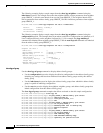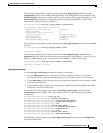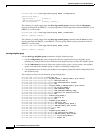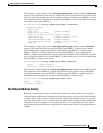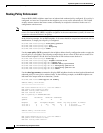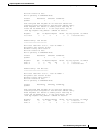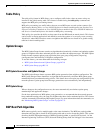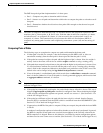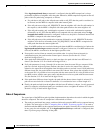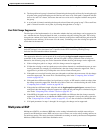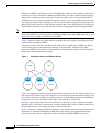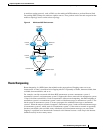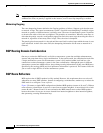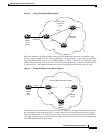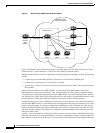
Implementing BGP on Cisco IOS XR Software
Information About Implementing BGP on Cisco IOS XR Software
RC-20
Cisco IOS XR Routing Configuration Guide
If the bgp bestpath med always command is configured, then the MED comparison is always
performed, regardless of neighbor AS in the paths. Otherwise, MED comparison depends on the AS
paths of the two paths being compared, as follows:
a. If a path has no AS path or the AS path starts with an AS_SET, then the path is considered to
be internal, and the MED is compared with other internal paths
b. If the AS path starts with an AS_SEQUENCE, then the neighbor AS is the first AS number in
the sequence, and the MED is compared with other paths that have the same neighbor AS
c. If the AS path contains only confederation segments or starts with confederation segments
followed by an AS_SET, then the MED is not compared with any other path unless the bgp
bestpath med confed command is configured. In that case, the path is considered internal and
the MED is compared with other internal paths.
d. If the AS path starts with confederation segments followed by an AS_SEQUENCE, then the
neighbor AS is the first AS number in the AS_SEQUENCE, and the MED is compared with
other paths that have the same neighbor AS.
Note: if no MED attribute was received with the path, then the MED is considered to be 0 unless the
bgp bestpath med missing-as-worst command is configured. In that case, if no MED attribute was
received, the MED is considered to be the highest possible value.
8. If one path is received from an external peer and the other is received from an internal (or
confederation) peer, the path from the external peer is chosen. (See Section 9.1.2.2d of
draft-ietf-idr-bgp4-24.txt.)
9. If the paths have different IGP metrics to their next hops, the path with the lower IGP metric is
chosen. (See Section 9.1.2.2e of draft-ietf-idr-bgp4-24.txt.)
10. If all path parameters in steps 1 through 10 are the same, then the router IDs are compared. If the
path was received with an originator attribute, then that is used as the router ID to compare;
otherwise, the router ID of the neighbor from which the path was received is used. If the paths have
different router IDs, the path with the lower router ID is chosen. Note: where the originator is used
as the router ID, it is possible to have two paths with the same router ID. It is also possible to have
two BGP sessions with the same peer router, and therefore receive two paths with the same router
ID. (See Section 9.1.2.2f of draft-ietf-idr-bgp4-24.txt.)
11. If the paths have different cluster lengths, the path with the shorter cluster length is selected. If a
path was not received with a cluster list attribute, it is considered to have a cluster length of 0.
12. Finally, the path received from the neighbor with the lower IP address is chosen. Locally generated
paths (for example, redistributed paths) are considered to have a neighbor IP address of 0. (See
Section 9.1.2.2g of draft-ietf-idr-bgp4-24.txt.)
Order of Comparisons
The second part of the BGP best path algorithm implementation determines the order in which the paths
should be compared. The order of comparison is determined as follows:
1. The paths are partitioned into groups such that within each group the MED can be compared among
all paths. The same rules as in the “Comparing Pairs of Paths” section on page RC-19 are used to
determine whether MED can be compared between any two paths. Normally, this comparison results
in one group for each neighbor AS. If the bgp bestpath med always command is configured, then
there is just one group containing all the paths.



